Tài liệu Hướng dẫn chẩn đoán điều trị, phục hồi chức năng đối với trẻ bại não
1.1. Sự cần thiết phải có các Tài liệu Hướng dẫn
Bại não là một rối loạn phức tạp. Đây là nguyên nhân phổ biến nhất gây ra tình trạng khuyết tật về
thể chất ở trẻ em, xuất phát từ nhiều bệnh nguyên khác nhau, dẫn đến các biểu hiện lâm sàng phong
phú và đa dạng. Sự đa dạng của bại não thể hiện ở các dạng khiếm khuyết vận động, các thể vận
động, các mức độ của rối loạn vận động (liên quan đến chức năng) và các thương tật thứ phát đi
kèm.
Trẻ bại não ở Việt Nam có các khiếm khuyết và nhu cầu hỗ trợ được giải quyết thông qua các hệ
thống chăm sóc sức khoẻ, chăm sóc phục hồi chức năng (PHCN) và chăm sóc xã hội. Các hướng
dẫn về xử lý trẻ bị bại não là cần thiết để:
● Hiểu rõ hơn về vai trò và trách nhiệm của các chuyên gia y tế trên tất cả các tuyến/mức độ
chăm sóc sức khoẻ và PHCN ở Việt Nam
● Cho phép tiếp cận kịp thời với các can thiệp thích hợp nhằm tăng cường tối đa các khả năng
chức năng và chất lượng cuộc sống cho trẻ bại não và gia đình trẻ.
Bộ Tài liệu Hướng dẫn này bao gồm các tài liệu sau: Hướng dẫn chẩn đoán can thiệp Phục hồi chức
năng chung, một Hướng dẫn Kỹ thuật cho Vật lý trị liệu và một Hướng dẫn Kỹ thuật cho Hoạt động
trị liệu và một Hướng dẫn Kỹ thuật cho Ngôn ngữ trị liệu. Các tài liệu này tập hợp lại tạo nên một
bộ các Hướng dẫn (được gọi là "các Hướng dẫn") để can thiệp toàn diện trẻ bại não.
Hướng dẫn về Ngôn ngữ trị liệu (NNTL) cho trẻ bại não này đưa ra các khuyến cáo và hướng
dẫn về hình thức chăm sóc PHCN cần được cung cấp cũng như các khuyến cáo kèm theo về hệ
thống tổ chức, chăm sóc đa ngành và toàn diện, chăm sóc lấy người bệnh làm trung tâm, hỗ trợ gia
đình và tham gia của gia đình, lộ trình chăm sóc và giới thiệu chuyển tuyến, xuất viện và theo dõi,
tái hoà nhập cộng đồng và tham gia vào xã hội.
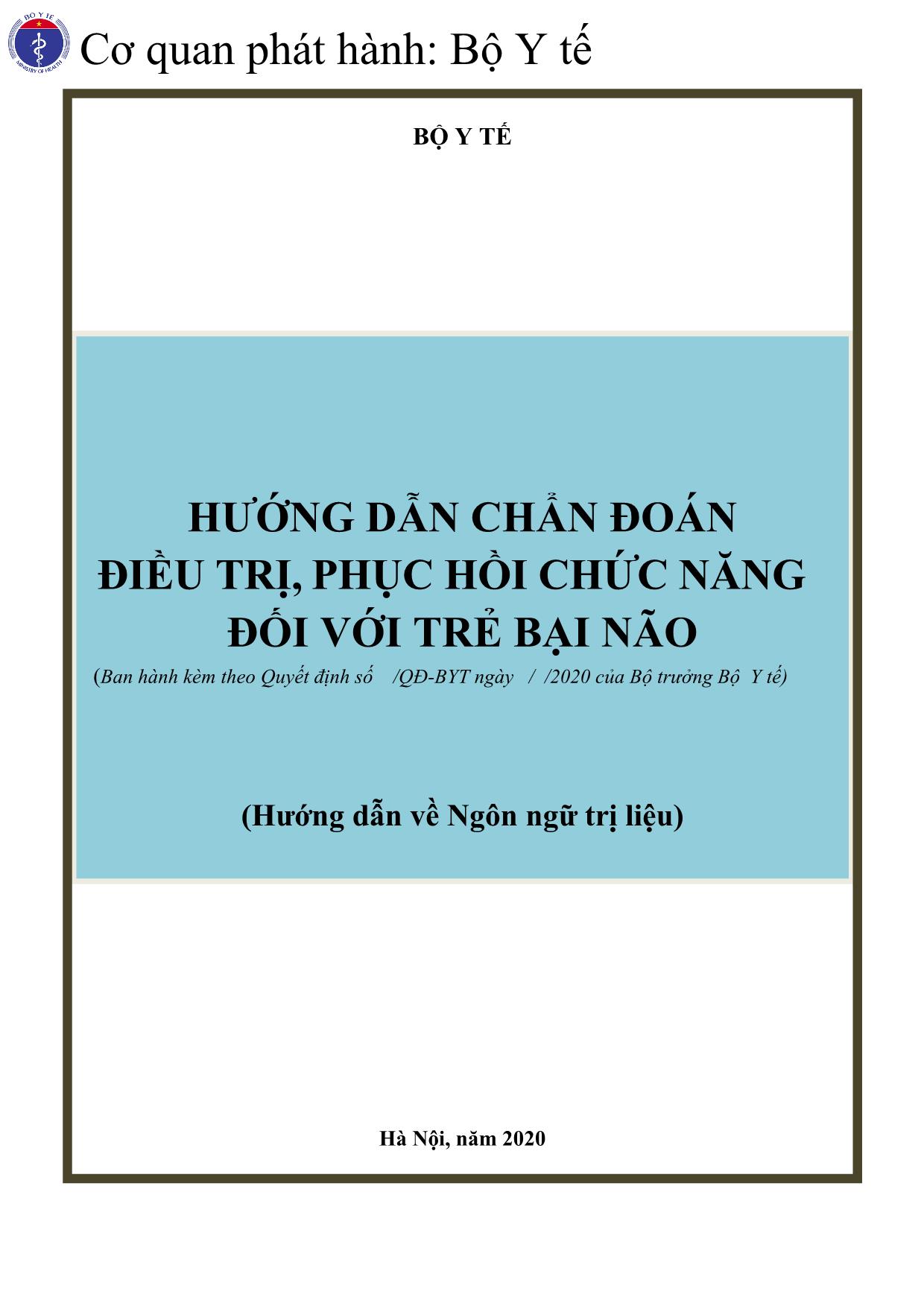
Trang 1

Trang 2
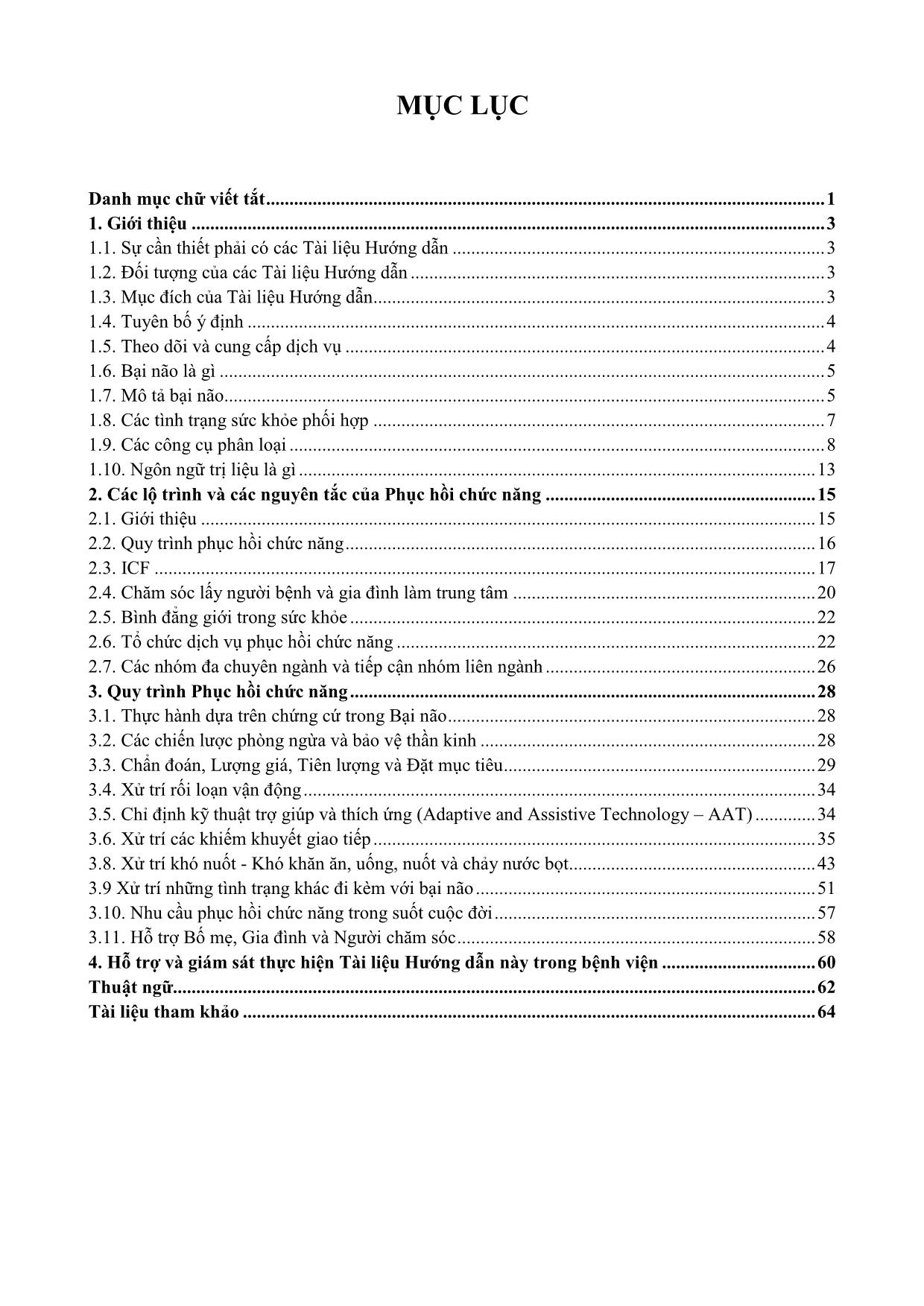
Trang 3

Trang 4
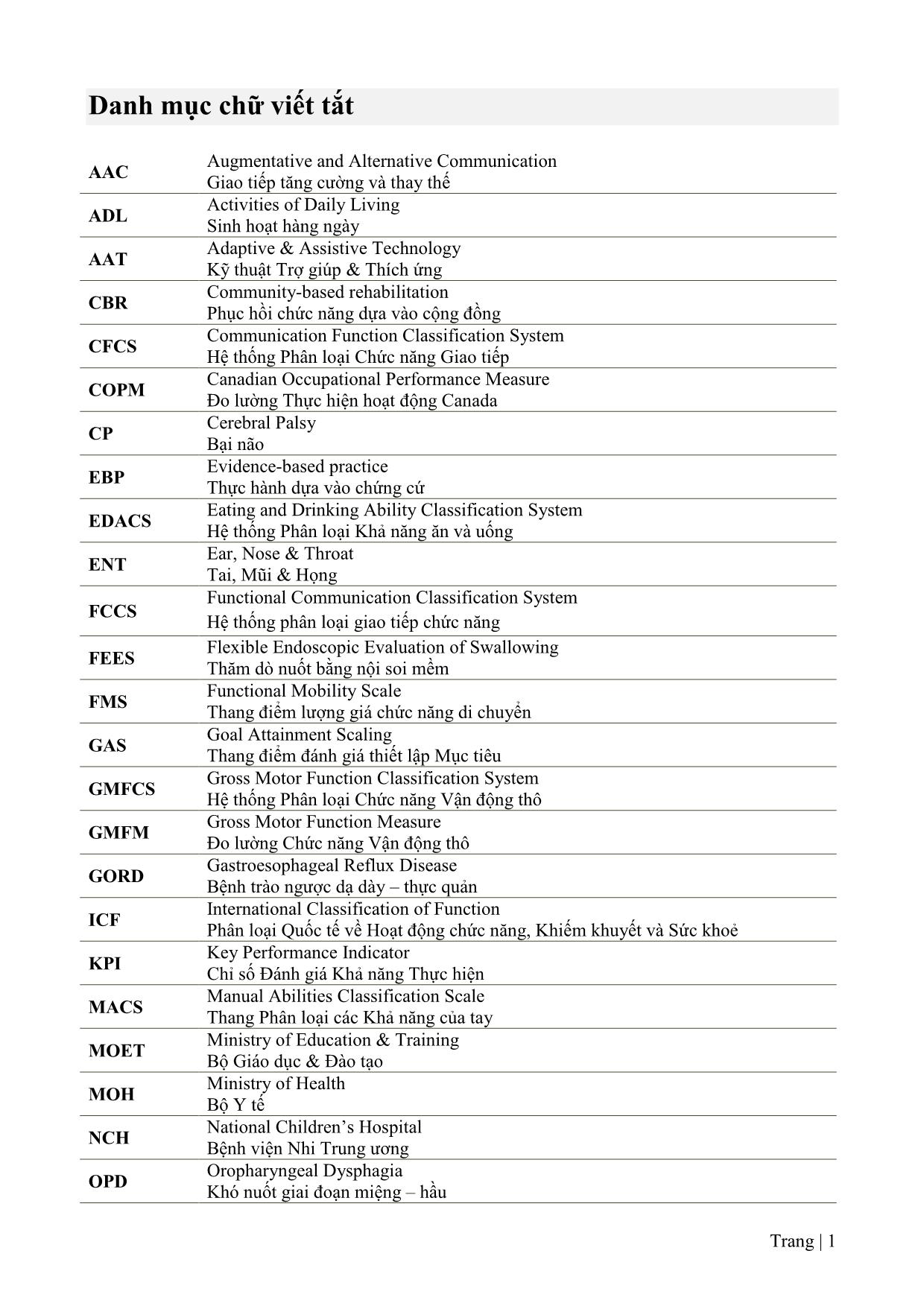
Trang 5
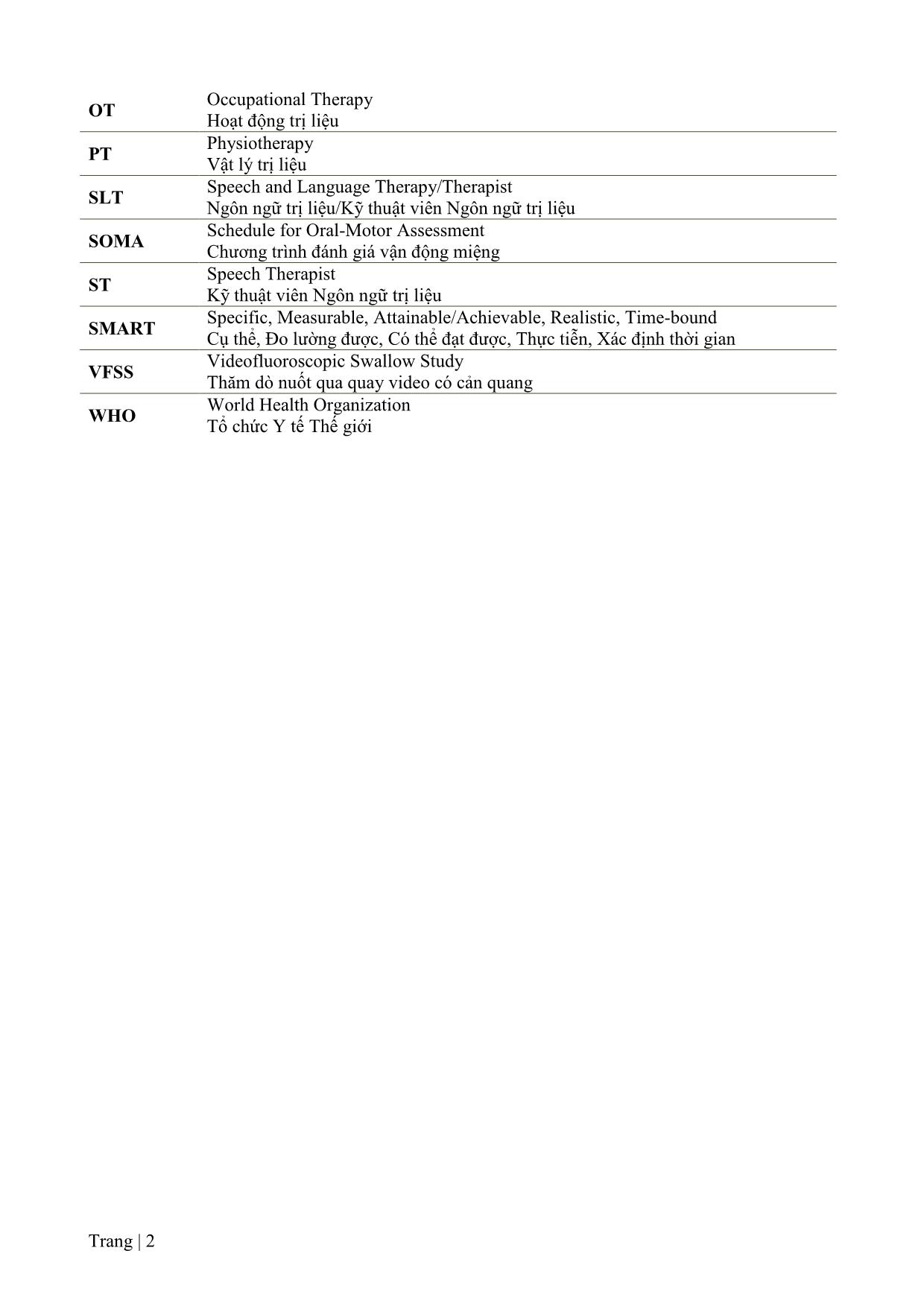
Trang 6

Trang 7
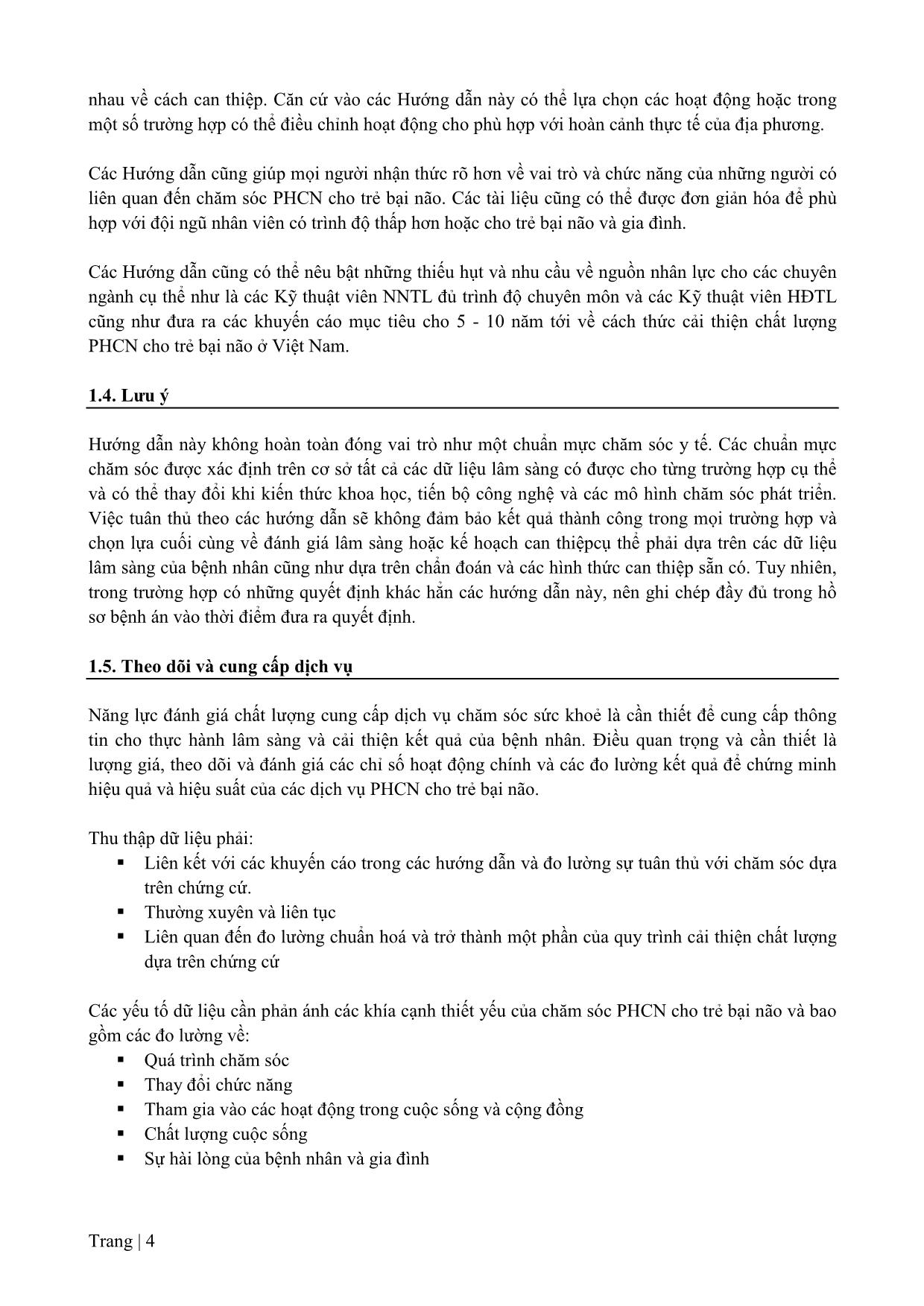
Trang 8
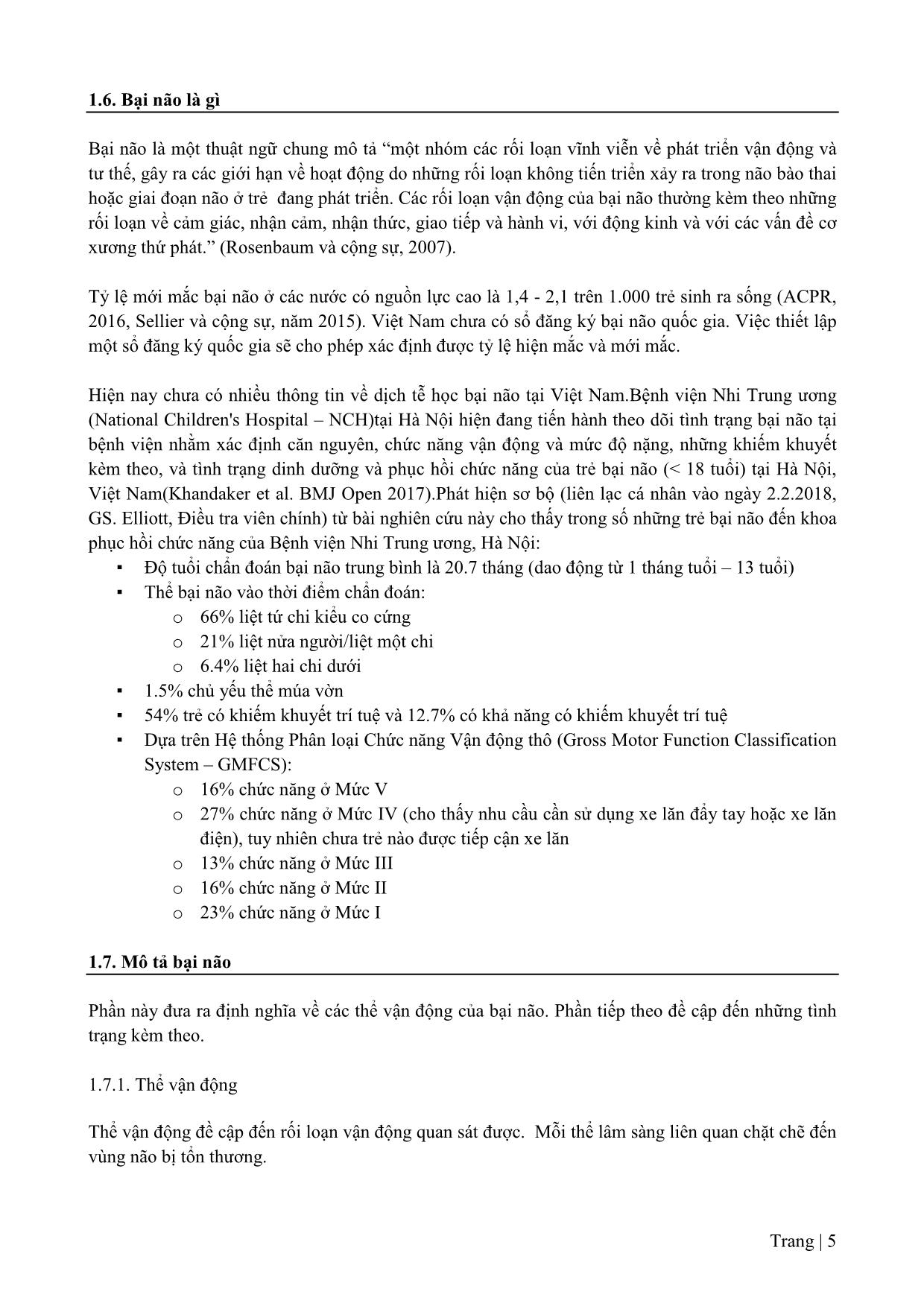
Trang 9
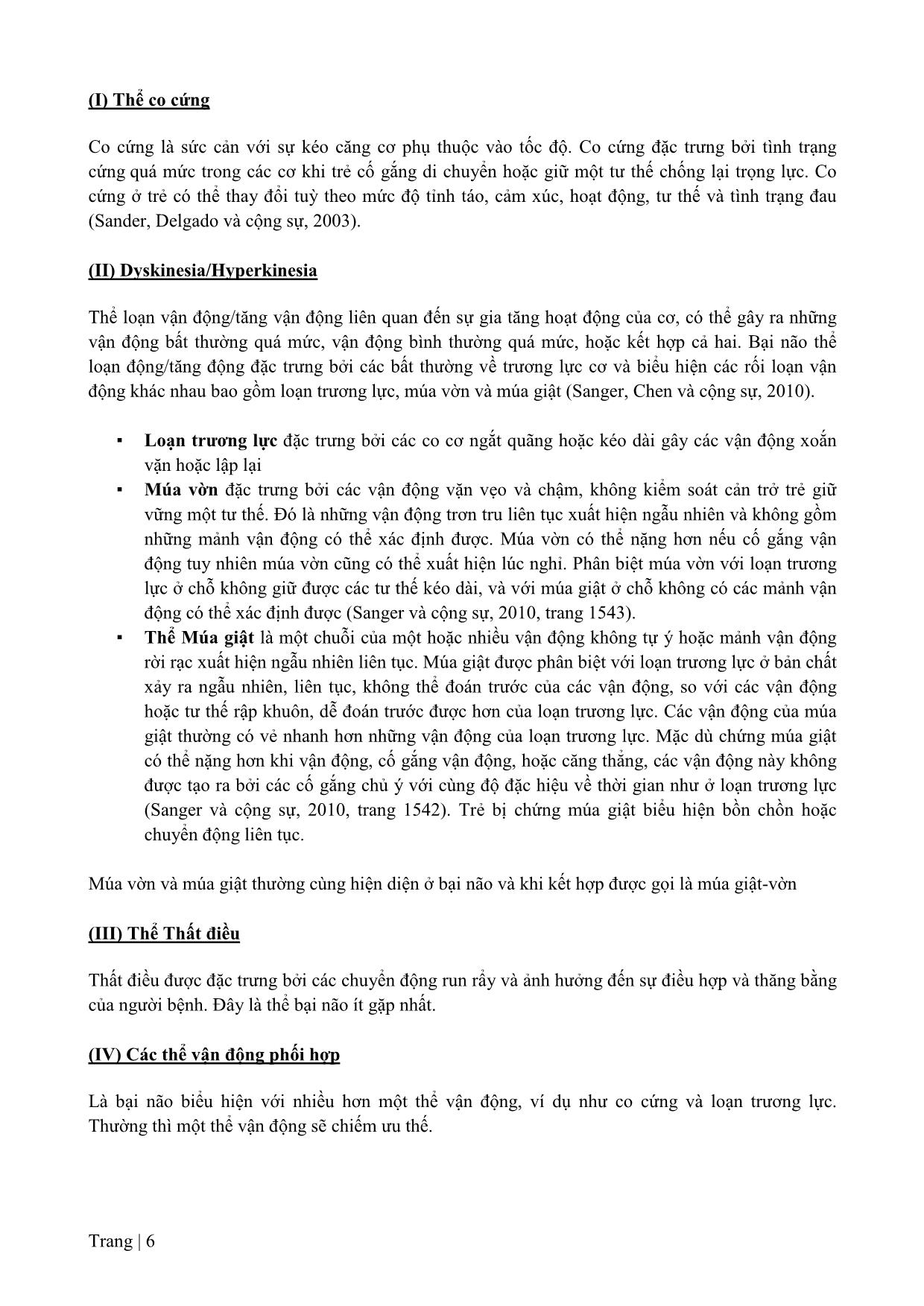
Trang 10
Tải về để xem bản đầy đủ
Tóm tắt nội dung tài liệu: Tài liệu Hướng dẫn chẩn đoán điều trị, phục hồi chức năng đối với trẻ bại não
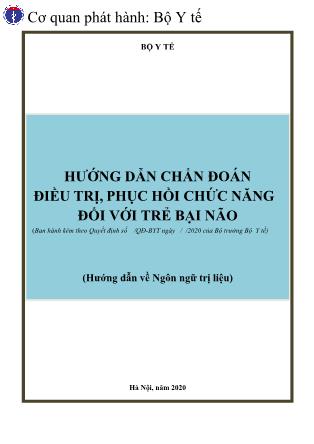
BỘ Y TẾ HƯỚNG DẪN CHẨN ĐOÁN ĐIỀU TRỊ, PHỤC HỒI CHỨC NĂNG ĐỐI VỚI TRẺ BẠI NÃO (Ban hành kèm theo Quyết định số /QĐ-BYT ngày / /2020 của Bộ trưởng Bộ Y tế) (Hướng dẫn về Ngôn ngữ trị liệu) Hà Nội, năm 2020 Tài liệu này được xây dựng với sự hỗ trợ của USAID trong khuôn khổ Dự án Tăng cường “Chăm sóc Y tế và Đào tạo Phục hồi chức năng” do Tổ chức Humanity &Inclusionthực hiện. MỤC LỤC Danh mục chữ viết tắt ........................................................................................................................ 1 1. Giới thiệu ........................................................................................................................................ 3 1.1. Sự cần thiết phải có các Tài liệu Hướng dẫn ................................................................................ 3 1.2. Đối tượng của các Tài liệu Hướng dẫn ......................................................................................... 3 1.3. Mục đích của Tài liệu Hướng dẫn ................................................................................................. 3 1.4. Tuyên bố ý định ............................................................................................................................ 4 1.5. Theo dõi và cung cấp dịch vụ ....................................................................................................... 4 1.6. Bại não là gì .................................................................................................................................. 5 1.7. Mô tả bại não................................................................................................................................. 5 1.8. Các tình trạng sức khỏe phối hợp ................................................................................................. 7 1.9. Các công cụ phân loại ................................................................................................................... 8 1.10. Ngôn ngữ trị liệu là gì ............................................................................................................... 13 2. Các lộ trình và các nguyên tắc của Phục hồi chức năng .......................................................... 15 2.1. Giới thiệu .................................................................................................................................... 15 2.2. Quy trình phục hồi chức năng ..................................................................................................... 16 2.3. ICF .............................................................................................................................................. 17 2.4. Chăm sóc lấy người bệnh và gia đình làm trung tâm ................................................................. 20 2.5. Bình đẳng giới trong sức khỏe .................................................................................................... 22 2.6. Tổ chức dịch vụ phục hồi chức năng .......................................................................................... 22 2.7. Các nhóm đa chuyên ngành và tiếp cận nhóm liên ngành .......................................................... 26 3. Quy trình Phục hồi chức năng .................................................................................................... 28 3.1. Thực hành dựa trên chứng cứ trong Bại não ............................................................................... 28 3.2. Các chiến lược phòng ngừa và bảo vệ thần kinh ........................................................................ 28 3.3. Chẩn đoán, Lượng giá, Tiên lượng và Đặt mục tiêu ................................................................... 29 3.4. Xử trí rối loạn vận động .............................................................................................................. 34 3.5. Chỉ định kỹ thuật trợ giúp và thích ứng (Adaptive and Assistive Technology – AAT) ............. 34 3.6. Xử trí các khiếm khuyết giao tiếp ............................................................................................... 35 3.8. Xử trí khó nuốt - Khó khăn ăn, uống, nuốt và chảy nước bọt..................................................... 43 3.9 Xử trí những tình trạng khác đi kèm với bại não ......................................................................... 51 3.10. Nhu cầu phục hồi chức năng trong suốt cuộc đời ..................................................................... 57 3.11. Hỗ trợ Bố mẹ, Gia đình và Người chăm sóc ............................................................................. 58 4. Hỗ trợ và giám sát thực hiện Tài liệu Hướng dẫn này trong bệnh viện ................................. 60 Thuật ngữ .......................................................................................................................................... 62 Tài liệu tham khảo .......................................... ... identifying operative patients in infants with gastroesophageal reflux disease. Journal of Laparoendoscopic & Advanced Surgical Techniques, 22(5); 518-520. Frakking, T.T, Chang, A. B., O’Grady, K.F., David, M., Walker-Smith, K., Weir, K.A. (2016). The use of cervical auscultation to predict oropharyngeal aspiration in Children: a randomised controlled trial. Dysphagia, 31(6);738–748 Frakking, T.T, Chang, A. B., O’Grady, K.F., David, M., Walker-Smith, K., Weir, K.A. (2016). The use of cervical auscultation to predict oropharyngeal aspiration in Children: a randomised controlled trial. Dysphagia, 31(6);738–748. Goh, Y., Choi, J.Y., Kim, S.A., Park, P., Park, E.S (2018).Comparisons of severity classification systems for oropharyngeal dysfunction in children with cerebral palsy: Relations with other functional profiles. Research in Developmental Disabilities,72; 248-256. Graham, H.K., Harvey, A., Rodda, J., Nattras, G.R. & Pirpiris, M. (2004). The functional mobility scale (FMS). Journal of Paediatric Orthopaedics, 24(5): 514-520. Hadders-Algra, M., Boxum, A.G., Hielkema, T., & Hamer, E.G. (2017) Effect of early intervention in infants at very high risk of cerebral palsy: a systematic review. Developmental Medicine & Child Neurology, 59:3,246-258 Trang | 66 Hanzlik, J. (1990). Interactions Between Mothers and Their Infants with Developmental Disabilities:. Physical & Occupational Therapy In Pediatrics, 9(4), pp.33-49. Hanzlik, J., & Stevenson, M. (1986). Interaction of Mothers with Their Infants Who Are Mentally Retarded, Retarded with Cerebral Palsy, or Nonretarded. American Journal of Mental Deficiency, 90(5), p.513-20. Harty, H., Griesel, M., & van der Merwe, A. (2011). The ICF as a common language for rehabilitation goal-setting: comparing client and professional priorities, Health and Quality of Life Outcomes, 9; 87. Health Innovation Network. Retrieved July, 2018 https://healthinnovationnetwork.com/system/ckeditor_assets/attachments/41/what_is_person- centred_care_and_why_is_it_important.pdf. Hidecker, M.J., Paneth, N., Rosenbaum, P.L., Kent, R.D., Lillie, J., Eulenberg, J.B., Chester, Jr. K., Johnson, B., Michalsen, L., Evatt, M.& Taylor, K. (2011). Developing and validating the Communication Function Classification System for individuals with cerebral. Developmental Medicine & Child Neurology, 53; 799-805. Hurn J., Kneebone, I., Cropley, M. (2006) Goal setting as an outcome measure: a systematic review. Clinical Rehabilitation, 20 (9); 756-772 International Diet Standardisation Initiative (IDDSI) Framework, (2016) Retrieved June 1, 2018 http//iddsi.org.framework/ Iverson, J. and Goldin-Meadow, S. (2005). Gesture Paves the Way for Language Development. Psychological Science, 16(5), pp.367-371. Jan, B.M., Jan,M.M. (2016) Dental health of children with cerebral palsy. Neurosciences, 21 (4): 314-318. Khandaker G, Van Bang N, Dũng TQ, Giang NTH, Chau CM, Van Anh NT, Van Thuong N, Badawi N, Elliott EJ. Protocol for hospital based-surveillance of cerebral palsy (CP) in Hanoi using the Paediatric Active Enhanced Disease Surveillance mechanism (PAEDS-Vietnam): a study towards developing hospital-based disease surveillance in Vietnam. BMJ Open. 2017 Nov 9;7(11):e017742 Kim, J.S., Han, Z.A., Song, D.H., Oh, H.M., Chung, M.E., (2013). Characteristics of dysphagia in children with cerebral palsy: Related to gross motor function. American Journal of Physical Medicine and Rehabilitation, 92; 912-919 Kim, S., Koh,H., & Soo Lee, J. (2017). Gastroesophageal Reflux in Neurologically Impaired Children: What Are the Risk Factors? Gut and Liver, (11) 2; 232-236. Kruijsen-Terpstra, A., Verschuren, O., Ketelaar, M., Riedijk, L., Gorter, J., Jongmans, M., & Boeije H. (2016). Parents' experiences and needs regarding physical and occupational therapy for their Trang | 67 young children with cerebral palsy. Research on Developmental Disabilities, 53-54; 314-22. doi: 10.1016/j.ridd.2016.02.012. Lane, M., Russell, D., Rosenbaum, P. & Avery, L. (2007). Gross Motor Function Measure: (GMFM-66 and GMFM-88) User’s Manual. MacKeith Press. Law, M., Rosenbaum, P., King, G., King, S., Evans, J. Premises, Principles, and Elements of Family-Centred Service. 2003 - CanChild Centre for Childhood Disability Research, McMaster University. Matsuo,K., Palmer, J.B. (2008).Anatomy and physiology of feeding and swallowing: Normal and abnormal. Physical Medicine and Rehabilitation Clinics of North America, 19; 691-707 McConachie, L. (1999). Mother-child interaction revisited: communication with non-speaking physically disabled children. International Journal of Language & Communication Disorders, 34(4), pp.391-416. McDougall, J. and King, G. (2007) Goal Attainment Scaling: Description, Utility, and Applications in Pediatric Therapy Services. (2nd ed.). London, ON: Thames Valley Children’s Centre. McLeod, S. (2004). Speech pathologists' application of the ICF to children with speech impairment. Advances in Speech Language Pathology, 6(1), pp.75-81. McLeod, S., Harrison, L. and McCormack, J. (2012). The Intelligibility in Context Scale: Validity and Reliability of a Subjective Rating Measure. Journal of Speech Language and Hearing Research, 55(2), p.648. National Institute for Health & Care Excellence (2017) Retrieved June, 2018. https://www.nice.org.uk/guidance/NG62/chapter/Recommendations#ftn.footnote_1. Novak, I., Hines, M., Goldsmith, S., Barclay, R. (2012) Clinical prognostic measures from a systematic review on cerebral palsy. Paediatrics 130 (5): e1285-1312. Novak, I., McIntyre.S., Morgan, C., Campbell, l., Dark, L., Morton, N., Stumbles, E., Wilson, A., Goldsmith, S. (2013) A systematic review of interventions for children with cerebral palsy:state of the evidence. Developmental Medicine & Child Neurology, 55; 885-910. Novak, I. (2014). Evidenced-based diagnosis, health care and rehabilitation for children with cerebral palsy. Journal of Child Neurology, 29; 1141-1156. Ogletree, B. and Pierce, H. (2009). AAC for Individuals with Severe Intellectual Disabilities: Ideas for Nonsymbolic Communicators. Journal of Developmental and Physical Disabilities, 22(3), pp.273-287. Palisano, R., Rosenbaum, P. Walter, S., Russell, D., Wood, E. & galuppi, B. (1997). Development and reliability of a system to classify gross motor function in children with cerebral palsy. Developmental Medicine & Child Neurology, 39(4): 214-223. Trang | 68 Palisano, R., Rosenbaum, P., Bartlett, D., Livingston, M. (2008). Content validity of the expanded and revised Gross Motor Function Classification System. Developmental Medicine & Child Neurology, 50 (10); 744-50. Parkes, J., Hill, N., . Platt, M.J., Donnelly, C. (2010). Oromotor dysfunction and communication impairments in children with cerebral palsy: A register study. Developmental Medicine & Child Neurology, 52, 1113-1119 Penner, M., Xie, W., Binepal, N., Switzer, L, & Fehlings, D. (2013). Characteristics of pain in children and youth with cerebral palsy. Pediatrics, 132(2); e407-413. Pennington, L. (2009). Effects of It Takes Two to Talk—The Hanen Program for Parents of Preschool Children With Cerebral Palsy: Findings From an Exploratory Study. Journal of Speech Language and Hearing Research, 52(5), p.1121. Pennington, L., Parker, N., Kelly, H. and Miller, N. (2016). Speech therapy for children with dysarthria acquired before three years of age. Cochrane Database of Systematic Reviews. Pennington, L., Virella, D., Mjøen, T., da Graça Andrada, M., Murray, J., Colver, A., Himmelmann, K., Rackauskaite, G., Greitane, A., Prasauskiene, A., Andersen, G. and de la Cruz, J. (2013). Development of The Viking Speech Scale to classify the speech of children with cerebral palsy. Research in Developmental Disabilities, 34(10), pp.3202-3210. Pirila, S., van der Meere, J., Pentikainen, T., Ruusu-Niemi, P., Korpela, R., Kilpinen, J. and Nieminen, P. (2007). Language and motor speech skills in children with cerebral palsy. Journal of Communication Disorders, 40(2), pp.116-128. Ramsay, M., Martel, C., Porporino, M., Zygmuntowiez, C. (2011). The Montreal Children’s Hospital Feeding Scale: A brief bilingual screening tool for identifying feeding problems. Paediatric Child Health, 16 (3); 147-151, e16-17. Reid, S.M., Johnson, H.M., Reddihough, D.S. (2010) The Drooling Impact Scale: a measure of the impact on drooling in children with developmental disabilities. Developmental Medicine and Child Neurology.52, e23-e28. Reid, S.M., McCutcheon, J., Reddihough, D.S.,Johnson, H.M. (2012) Prevalence and predictors of drooling in 7‐ to 14‐year‐old children with cerebral palsy: a population study. Developmental Medicine & Child Neurology, 54(11); 1032-1036 Reid, S.M., Modak, M.B., Berkowitz, R.G. & Reddihough, D.S. (2011).A population‐based study and systematic review of hearing loss in children with cerebral palsy. Developmental Medicine & Child Neurology, 53(11);1038-1045 Reilly, S., Skuse.D. (1992). Characteristics and management of feeding problems of young children with cerebral palsy. Developmental Medicine & Child Neurology, 34; 379-388. Reilly S, Skuse D, Wolke D.(2000) Schedule for oral motor assessment. London: Whurr Publishers. Rosenbaum, P., Paneth, N., Leviton, A., Goldstein, M. and Bax, M. (2007). A report: the definition and classification of cerebral palsy. Developmental Medicine & Child Neurology, Supplement, 109; 8-14. Trang | 69 Rosenbaum, P. and Stewart, D. (2004). The World Health Organization International Classification of Functioning, Disability, and Health: A Model to Guide Clinical Thinking, Practice and Research in the Field of Cerebral Palsy. Seminars in Pediatric Neurology, 11(1); 5-10. Sackett, D.L., Rosenberg, W.M.C., Gray, J.A.M., Haynes, R.B., Richardson, W.S. (1996) Evidence based medicine: what it is and what it isn't. BMJ, 312:71. Sandberg, A. and Liliedahl, M. (2008). Patterns in early interaction between young preschool children with severe speech and physical impairments and their parents. Child Language Teaching and Therapy, 24(1), pp.9-30. Sanger, T.D., Delgado, M.R., Gaebler-Spira, D., Hallett, M. & Mink, J.W. (2003). Task force on childhood motor disorders. Classification and definition of disorders causing hypertonia in childhood. Pediatrics, 111: e89-97. Sanger, T.D., Chen et.al (2010). Definition and classification of hyperkinetic movements in childhood. Movement Disorders, 25(11);1538-1549. Sano, M., Kaga, K., Kitazumi, E. & Kodama, K. (2005) Sensorineural hearing loss in patients with cerebral palsy after asphyxia and hyperbilirubinemia. International Journal of Pediatric Otorhinolaryngology,69 (9); 1211-1217. Sellers, D., Mandy, A., Pennington, L., Hankins, M. & Morris, C. (2014). Development and reliability of a system to classify the eating and drinking ability of people with cerebral palsy. Developmental Medicine & Child Neurology, 56(3); 245-51. Sellier, E., Platt, M.J., Andersen, G., Krageloh-Mann, I., De La Cruz, J. and Cans, C. (2015). Decreasing prevalence in cerebral palsy: a multi-site European population-based study, 1980 to 2003. Developmental Medicine & Child Neurology, 58: 85–92. Sherman, P.M., Hassall, E., Fagundes-Neto, U., Gold, B.D., Kato, S., Koletzo,S., Orenstein, S., Rudolph, C., Vakil, N. & Vandenplas,Y. (2009) A global, evidence-based consensus on the definition of gastroesophageal reflux disease in the pediatric population. The American Journal of Gastroenterology 104; 1278–1295. Sigurdardottir, S. and Vik, T. (2010). Speech, expressive language, and verbal cognition of preschool children with cerebral palsy in Iceland. Developmental Medicine & Child Neurology, 53(1), pp.74-80. Simces Z. (2003). Exploring the link between public involvement/citizen engagement and quality health care. A review and analysis of the current literature. Health Canada.Ottawa Slonims, V. and McConachie, H. (2006). Analysis of Mother–Infant Interaction in Infants With Down Syndrome and Typically Developing Infants. American Journal on Mental Retardation, 111(4), p.273. Speech Pathology Australia (2012). Charter & Scope of Practice. Retrieved: July 20, 2018. Trang | 70 www.speechpathologyaustralia.org/SPAweb/About_us/SPA_Documents Speech Pathology Australia (2012). Dysphagia Clinical Guideline. Retrieved: July 20, 2018. www.speechpathologyaustralia.org Stewart, L. (2003) Development of the Nutrition and Swallowing Checklist, a screening tool for nutrition risk and swallowing risk in people with intellectual disability. Journal of Intellectual & Developmental Disability, 28:2, 171-187. Swan, K., Cordier, R. Brown, T., Speyer, R. (2018) Psychometric Properties of Visuoperceptual Measures of Videofluoroscopic and Fibre-Endoscopic Evaluations of Swallowing: A Systematic Review. Dysphagia doi: 10.1007/s00455-018-9918-3. [Epub ahead of print] Trinick, R., Johnston, N., Dalzell, A.M, & McNamara, P.S (2012). Reflux aspiration in children with neurodisability—a significant problem, but can we measure it? Journal of Paediatric Surgery, 47(2);291-298. Turner-Stokes, L. (2009) “Goal Attainment Scaling (GAS) in rehabilitation: a practical guide.” Clinical Rehabilitation, 23, 4, 362-370. Van Hulst, K., Lindeboom, R., van der Burg, J., Jongerius, P. (2012) Accurate assessment of drooling severity with the 5‐minute drooling quotient in children with developmental disabilities. Developmental Medicine and Child Neurology,54 (12); 1121-1126. UNICEF Retrieved July, 2018 https://www.unicef.org Van Hulst, K.V., Lindeboom, R., Van Der Burg, J., Jongerius, P. (2012) Accurate assessment of drooling severity with the 5- minute drooling quotient in children with developmental disabilities. Developmental Medicine & Child Neurology, 54, 1121-1126 https://www.aacpdm.org/UserFiles/file/drooling-quotient-instructions.pdf Waterman, E.T., Koltai. P.J., Downey. J.C., Anthony T., Cacace, A.T.(1992)Swallowing disorders in a population of children with cerebral palsy. International Journal of Pediatric Otorhinolaryngology,24, 1, 63-71 Wilson, E.M., Hustad,K.C. (2009). Early feeding abilities in children with cerebral palsy: A parental report study. Journal of Medical Speech-Language Pathology 1-16. World Health Organization. (2001). International classification of functioning, disability and health. Geneva: Author. World Health Organization. (2006). Constitution of the World Health Organization (45th ed.).Retrieved from 111WHO 2006 Yoder, P. and Warren, S. (2002). Effects of Prelinguistic Milieu Teaching and Parent Responsivity Education on Dyads Involving Children With Intellectual Disabilities. Journal of Speech Language and Hearing Research, 45(6), p.1158.
File đính kèm:
 tai_lieu_huong_dan_chan_doan_dieu_tri_phuc_hoi_chuc_nang_doi.pdf
tai_lieu_huong_dan_chan_doan_dieu_tri_phuc_hoi_chuc_nang_doi.pdf

